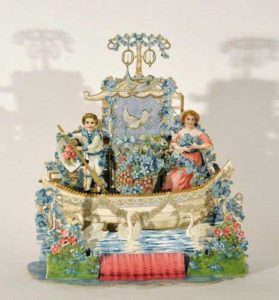Small Home Gazette, Winter 2015
Valentines in the Arts & Crafts Era
In the late 1800s and early 1900s, it was not unusual for Valentine’s Day cards and gifts to be elaborate and expensive—a three-dimensional card plus a box of handmade lace, flowers, candy, and sometimes a silk garter—delivered for $100 or more.
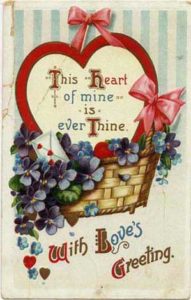 In contrast, demand for the penny postcard exploded in 1907 when the U.S. Post Office approved a “divided back” design (message on left, address on right), leaving the front open for a photograph or artwork. The best cards were imported from Germany, where high quality printing techniques produced beautifully colored, and sometimes embossed, cards.
In contrast, demand for the penny postcard exploded in 1907 when the U.S. Post Office approved a “divided back” design (message on left, address on right), leaving the front open for a photograph or artwork. The best cards were imported from Germany, where high quality printing techniques produced beautifully colored, and sometimes embossed, cards.
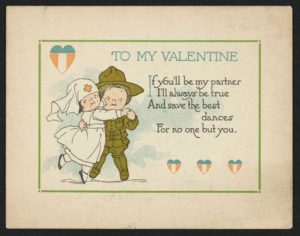 The Golden Age of American postcards ended with WWI, which stopped the printing and import of fine German cards. With so many young men overseas, the demand for valentines grew significantly. U.S. printers filled the gap but their printing inexperience resulted in lower quality cards. Thus, handmade cards experienced a renaissance.
The Golden Age of American postcards ended with WWI, which stopped the printing and import of fine German cards. With so many young men overseas, the demand for valentines grew significantly. U.S. printers filled the gap but their printing inexperience resulted in lower quality cards. Thus, handmade cards experienced a renaissance.
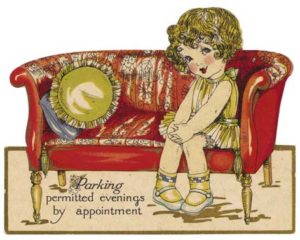 In the 1800s, men were the predominant senders of valentines, while women waited anxiously to see what would arrive at their door. It was popular for women to collect their valentines in scrapbooks to display in the parlor for visitors. As attitudes toward women’s roles changed in the early 1900s, more women began sending valentines without risk to their social reputation.
In the 1800s, men were the predominant senders of valentines, while women waited anxiously to see what would arrive at their door. It was popular for women to collect their valentines in scrapbooks to display in the parlor for visitors. As attitudes toward women’s roles changed in the early 1900s, more women began sending valentines without risk to their social reputation.
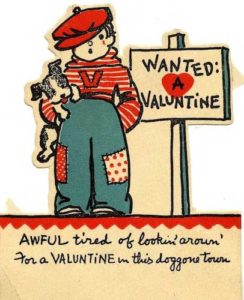 Not all valentines expressed romantic feelings. In the late 1800s, humorous cards became a fad with many relying on bawdy jokes and burlesque-style illustration. In the 1900s, “vinegar valentines” emerged with insulting references to one’s appearance, personality or lack of romantic success. But by the late 1920s, valentines featuring children, animals and amusing verses were popular.
Not all valentines expressed romantic feelings. In the late 1800s, humorous cards became a fad with many relying on bawdy jokes and burlesque-style illustration. In the 1900s, “vinegar valentines” emerged with insulting references to one’s appearance, personality or lack of romantic success. But by the late 1920s, valentines featuring children, animals and amusing verses were popular.
Some historians state the Norcross Company, formed in the mid-1920s in New York City, was the first to mass-produce valentines in the United States. The company developed many of its own valentines but also employed a large network of freelance designers to maintain the appearance of a personalized touch.
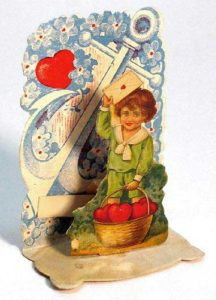 We can’t overlook Hallmark. Valentines were among the first types of postcards the Hall brothers sold. A 1915 fire destroyed their inventory but led them to buy printing presses and begin producing their own high quality seasonal greeting cards with envelopes.
We can’t overlook Hallmark. Valentines were among the first types of postcards the Hall brothers sold. A 1915 fire destroyed their inventory but led them to buy printing presses and begin producing their own high quality seasonal greeting cards with envelopes.
While our traditions change, some things never go out of style—like the first lines of this familiar verse from 1784’s “A Collection of English Nursery Rhymes.”
The rose is red, the violet’s blue
The honey’s sweet, and so are you









